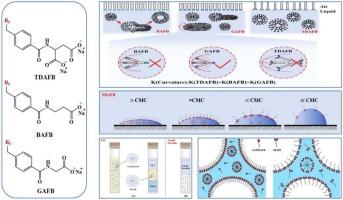Effects of double hydrophilic head groups on the thermodynamic parameters, aggregation behavior, and foam characteristics of amino acid-based fluorocarbon surfactants
IF 4.3
2区 工程技术
Q2 ENGINEERING, CHEMICAL
引用次数: 0
Abstract
This paper presents an innovative fluorocarbon surfactant architecture that synergistically merges the superior surface activity of fluorocarbon surfactants with the environmental compatibility of biodegradable amino acid surfactants. Through this molecular design strategy, a series of amino acid-based fluorocarbon surfactants (TDAFB, GAFB, and BAFB) that inherit the advantageous characteristics of both constituent materials have been successfully synthesized. On this basis, compared to GAFB and BAFB with a single hydrophilic head group, the performance of TDAFB with double hydrophilic head groups should be significantly affected. Research demonstrates that all three compounds display outstanding surface activity. Nevertheless, TDAFB exhibits higher surface tension (γCMC = 21.18 mN/m) and critical micelle concentration (CMC = 0.009926 mol/L), attributable to the larger Amin and the stronger electrostatic repulsion of the double hydrophilic head groups. Furthermore, the double hydrophilic head groups also significantly affect physical and chemical characteristics of TDAFB, encompassing solubility, molecular aggregation behavior, as well as emulsion and foam stabilization capacities. In contrast, despite exhibiting a marginally lower dissolution rate, BAFB with a single hydrophilic head group is superior to TDAFB with the double hydrophilic head groups across all other metrics. This review provides a new approach for the development of novel environmentally friendly fluorocarbon surfactants.

双亲水性头基对氨基酸基氟碳表面活性剂热力学参数、聚集行为和泡沫特性的影响
本文提出了一种创新的氟碳表面活性剂结构,它将氟碳表面活性剂的优越表面活性与生物可降解氨基酸表面活性剂的环境相容性协同融合。通过这种分子设计策略,成功合成了一系列氨基酸基氟碳表面活性剂(TDAFB、GAFB和BAFB),它们继承了这两种组成材料的优势特性。在此基础上,与具有单亲水头组的GAFB和BAFB相比,具有双亲水头组的TDAFB的性能应受到显著影响。研究表明,这三种化合物都具有出色的表面活性。然而,由于双亲水头基团具有较大的Amin和较强的静电斥力,TDAFB具有较高的表面张力(γCMC = 21.18 mN/m)和临界胶束浓度(CMC = 0.009926 mol/L)。此外,双亲水头基团也显著影响TDAFB的物理和化学特性,包括溶解度、分子聚集行为以及乳液和泡沫稳定能力。相比之下,尽管表现出稍低的溶解速度,具有单一亲水头基团的BAFB优于具有双亲水头基团的TDAFB在所有其他指标。本文综述为开发新型环保型氟碳表面活性剂提供了新的途径。
本文章由计算机程序翻译,如有差异,请以英文原文为准。
求助全文
约1分钟内获得全文
求助全文
来源期刊

Chemical Engineering Science
工程技术-工程:化工
CiteScore
7.50
自引率
8.50%
发文量
1025
审稿时长
50 days
期刊介绍:
Chemical engineering enables the transformation of natural resources and energy into useful products for society. It draws on and applies natural sciences, mathematics and economics, and has developed fundamental engineering science that underpins the discipline.
Chemical Engineering Science (CES) has been publishing papers on the fundamentals of chemical engineering since 1951. CES is the platform where the most significant advances in the discipline have ever since been published. Chemical Engineering Science has accompanied and sustained chemical engineering through its development into the vibrant and broad scientific discipline it is today.
 求助内容:
求助内容: 应助结果提醒方式:
应助结果提醒方式:


